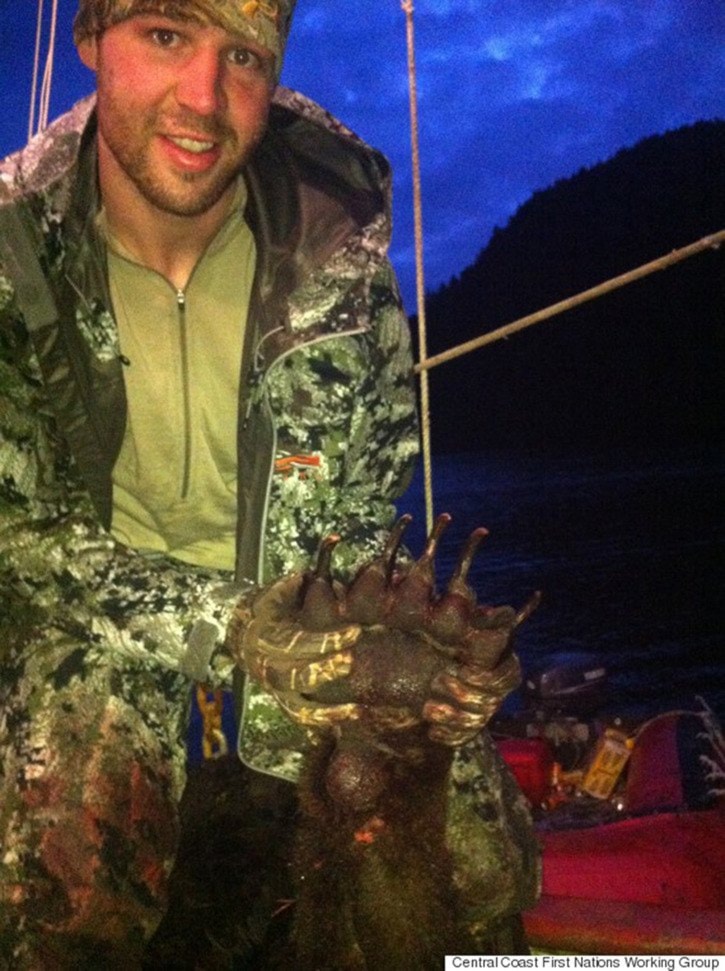Clayton Stoner is facing five charges under the Wildlife Act for a spring grizzly bear hunt near Bella Coola in 2013.
Stoner, who was the subject of intense scrutiny after a leaked photo showed the hockey star holding the severed head and paws of a five-year old grizzly he shot in Kwatna, is now facing two counts of knowingly making a false statement to obtain a licence, hunting without a licence, hunting out of season and unlawful possession of dead wildlife.
All five charges relate to the accusation that Stoner could not have been considered a resident of B.C., as was required by his permit to shoot the bear, because his main residence would have been the U.S. city where he lived as part of his NHL career.
Stoner, who now plays for the Anaheim Ducks, is accused of falsely claiming to be a B.C. resident when he applied for the licence, according to Det. Sgt. Cynthia Mann with the Conservation Officer Service.
“At the time Mr. Stoner was playing for the Minnesota Wild hockey team so the question of his B.C. residence initiated an investigation,” said Mann.
According to the B.C. Wildlife Act, resident means a person who is a Canadian citizen or a permanent resident, whose primary residence is in B.C., and has been physically present in B.C. for the greater portion of each of six out of the 12 months immediately preceding making an application.
Stoner was also the subject of a documentary film released by the Coastal First Nations entitled “Bears Forever,” which detailed the shooting of the bear, nicknamed “Cheeky” by the Guardian Watchmen of the area.
The area also falls under the traditional territory of the Coastal First Nations, who issued a ban on all trophy hunting in their region in 2012.
Jessie Housty, who is a councillor with the Heiltsuk Nation, told regional media that while they welcomed the charges, they would rather the province ban trophy hunting altogether.
“I think it’s positive in the sense that I hope it makes trophy hunters aware that they’re being policed and that they're being held to a very high standard,” said Housty. “However, it is still legal for them to do this under law and you could just as easily read the situation as an opportunity to learn from Clayton Stoner’s mistakes and keep their nose clean when they’re practising their own trophy hunting. In that sense, it’s not really a win for us.”
Critics of the trophy hunt have long argued that government science is inaccurate and that the practice should be banned for a number of reasons, including the assertion from First Nations leaders that their indigenous laws should be respected.
October 1 will mark the opening of B.C.’s controversial grizzly bear hunt and Central and North Coast First Nations are saying they will step up their actions against hunters found in their territory.
The B.C. government authorized 3,469 grizzly bear tags in 2015, up from 3,067 in 2014 but down from 3,786 in 2013. On average, hunters have killed about 270 grizzly bears in British Columbia every year since 2010. The province estimates there to be 15,000 grizzlies in British Columbia – about a quarter of the entire North American population.
Douglass Neasloss, Chief Councilor of the Kitasoo-Xaixais, believes that both the government’s scientific and economic modeling is flawed and that there is no way to sustainably or ethically support a grizzly bear hunt in the Great Bear Rainforest, or anywhere else for that matter.
Neasloss said that all aspects of the grizzly bear hunt are in complete opposition to his community’s culture, and that the Coastal Guardian Watchmen will be stepping up their patrols to ensure hunters get the message.
